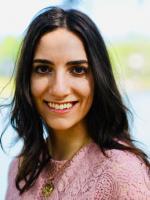
Student Profiles

1 Search Results

Samantha Lish
NIH Oxford Scholar
B.A. Physics and Art, Macaulay Honors College CUNY
Dr. Alexander Cartagena-Rivera (NIBIB)
and Prof. Ramin Golestanian (Oxford)
Biomedical optics, Mathematics, Theoretical biophysics
Samantha is a graduate of the Macaulay Honors Program at Hunter College of the City University of New York, where she received a degree with a double major in Physics and Studio Art, and a minor in Mathematics. During her undergraduate career, Samantha was inducted into the Phi Beta Kappa International Academic Honor Society, received the Gillet Memorial Prize for excellence in Physics, the John P. McNulty Research Award for Leadership in Math and Science, and the Toulmin Healthcare Merit Scholarship, which supported her work in Biophotonics. Samantha believes that in order to problem-solve, it is helpful to call upon influences from many different fields. In addition to being a scientific thinker, she is an artist, which gives her an added appreciation for the beauty of mathematics and characteristic patterns of disease in image processing and 3D modeling. Her research has focused on developing computational and optical tools to guide medical diagnostics. Samantha spent four years as a research assistant at The Rockefeller University analyzing microscopic properties of tissue, applying feature engineering and machine learning techniques to characterize disease patterns for quantifiable metrics, and developing 3D-bioprinting assays. At Hunter’s Biomedical Photonics lab, Samantha spearheaded a project to extract diagnostic value from differences in cancer fractal geometric parameters. She applied these image processing and laser physics techniques as a part of the Harvard-MIT Wellman Center for Photomedicine, where she investigated the biocompatibility of integrating intracellular micro-resonators into a spheroid cancer model and developed a quantitative approach to track and tag these laser particles. As an NIH OxCam Scholar, in partnership with the NIBIB at the NIH and the Department of Theoretical Physics at Oxford University, Samantha will utilize the formalism of mathematics, mechanobiology, and quantum mechanics to uncover emergent geometrical properties that arise from the unique spatial distribution and collective migration of organotypic cells. Upon graduation hopes to pursue an academic research career and become a professor at the university level.


